Fig. 533 Tympanomeatoplasty with preservation of the bony bridge (Wigand). Example of extensive removal of the bony ear canal wall, apart from a small displaced bridge. A large atticoantrotomy is performed, and only a small, superolaterally displaced bridge is preserved (arrow) in a situation with posterior perforation and an intact ossicular chain. This situation resembles a canal wall–down technique, i. e., a transmeatal atticoantrotomy with preserved bridge
The drilling commerces, using a sharp cutting burr, enlarging the ear canal by about 2 mm in its entire posterior circumference (Fig. 535). Similar enlargement of the ear canal has been used by Brunar in his intact canal wall mastoidectomy (Fig. 261) (Brunar 1958, 1959), showing that the bony ear canal can remain intact even if it is posteriorly displaced by about 2 mm with transmeatal drilling.
It is easy to enlarge the entire ear canal through the transmeatal route (Fig. 535), and a small atticotomy can be performed by removing some of the bony annulus. With further drilling, the atticotomy can be extended posterosuperiorly, to the incus body or malleus head. Transmeatal antrotomy or even mastoidectomy can be performed by the transmeatal route (Fig. 536).
The transmeatal drilling continues, with the bone being removed along the tympanosquamous suture. Although widening of the ear canal by 2 mm still results in an intact ear canal wall, the bony bridge will be displaced superolaterally if the widening is performed at the level of the annulus (Fig. 537). Further widening of the bony ear canal results in an antrum opening, and an antrotomy behind the bony bridge may be performed and further enlarged, if necessary (Fig. 538).
The bony annulus is then drilled away between the 2-o’clock and 9-o’clock positions (Fig. 537), exposing a part of the anterior attic, the malleolar ligament, and posteriorly, the stapes, the horizontal part of the facial nerve, and the facial sinus, with the lateral tympanic sinus and the pyramidal eminence (Fig. 537). Any pathology from the tympanic cavity, for instance sinus cholesteatoma, is then removed, and the cholesteatoma membrane is carefully elevated, preserving the middle ear mucosa and the bony structures as far as possible intact.
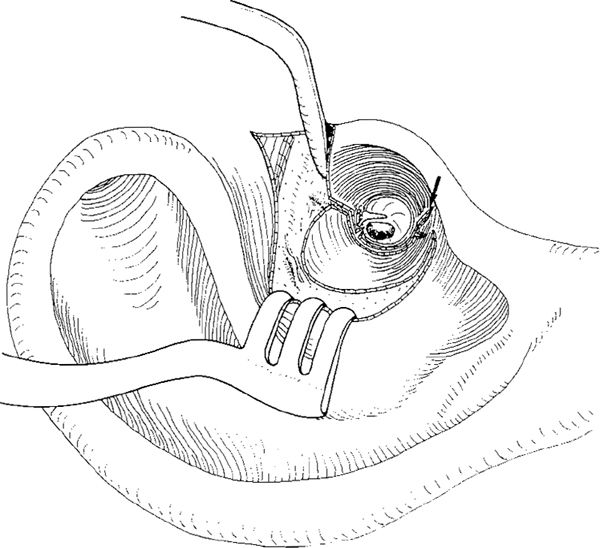
Fig. 534 The endaural incision in Wigand’s technique. An intercartilaginous incision is made at the 12-o’clock position and a small vertical incision anterior to the helix. Between the 12-o’clock and 6-o’clock positions, a lateral circumferential incision at the level of Henle’s spine and a medial circumferential incision 4 mm lateral to the annulus are performed. This incision is prolonged anterolaterally over the anterior canal wall in order to allow an easier retraction of the Stacke II canal skin flap (arrow)
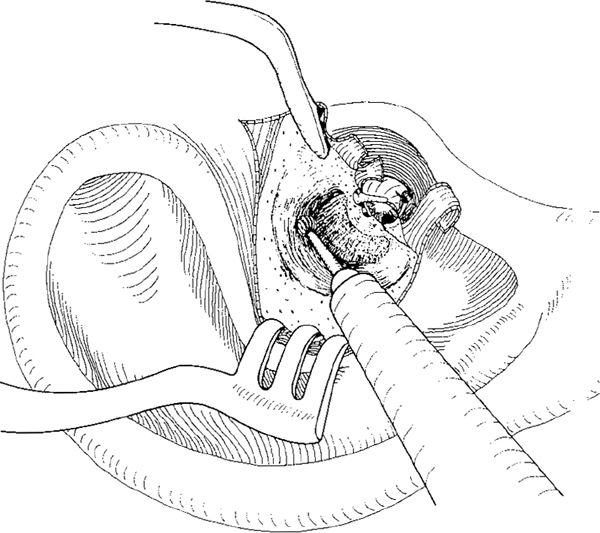
Fig. 535 A large Stacke II flap is elevated. Medially, superior and inferior tympanomeatal flaps are elevated (arrow). The ear canal is widened using a cutting burr
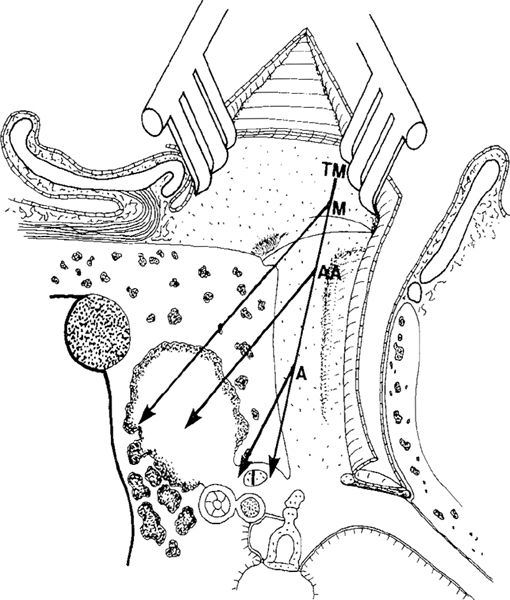
Fig. 536 Side view of the endaural approach, illustrating the transmeatal (TM) drilling route for atticotomy (A), inferior or superior to the incus body (I), for atticoantrotomy (AA) and mastoidectomy (M)
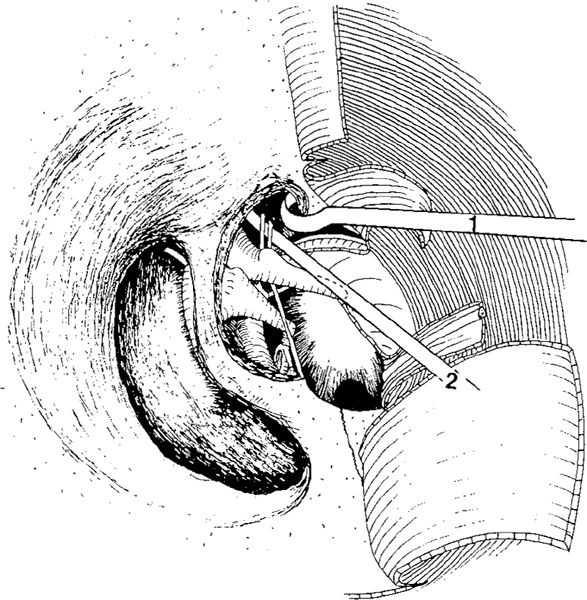
Fig. 537 Tympanomeatoplasty with preservation of the bony bridge. After extensive transmeatal enlargement of the ear canal, an antrotomy opening is performed. Medially, a small atticotomy is performed, exposing the anterior malleolar ligament, the neck of the malleus, and the long process of the incus, as well as the mesotympanum. Atticotomy drilling can be extended posteriorly. Under the anterior remnant of the bridge, the epitympanic sinus can be entered transmeatally (1) or transtympanically (2) under the anterior malleolar ligament and chorda tympani
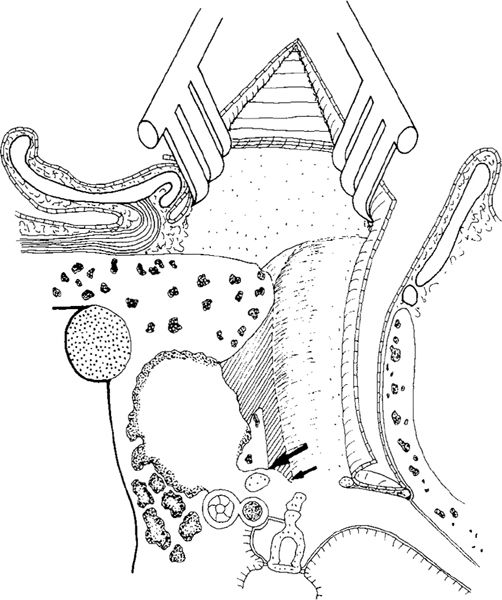
Fig. 538 Side view of the tympanomeatoplasty with preservation of the bony bridge. The ear canal is widened for about 2 mm, and an antrum control opening is performed (shaded area). Medially, the removal of the bony annulus (small arrow) creates a small atticotomy inferior to the malleus and incus. With further removal of the bony bridge, a larger atticotomy can be performed (large arrow)
If the pathology requires it, for instance if there is a deep sinus cholesteatoma, further drilling of the posterior bony annulus, around the chorda tympani, can be performed (Fig. 537), providing exposure to all four tympanic sinuses. In attic cholesteatoma, further drilling allows transmeatal exposure of the epitympanic sinus and removal of the pathology both transtympanally, under the remaining bony bridge, as well as transmeatally, under the malleolar ligament and chorda tympani. If necessary, further drilling of the lateral attic wall can be performed in order to achieve better exposure of the anterior attic. The anterior bony plate (the cog) must be drilled away in order to open the epitympanic sinus and the protympanum (Fig. 537).
The drilling continues posteriorly, and the lateral half of the ear canal is drilled away in order to widen the antrotomy opening (Fig. 539). Further drilling is performed along the mastoid tegmen and tegmen antri, and especially on the posterior aspect of the preserved bony ear canal wall, in order to make it as thin as possible (Fig. 540).
By tilting the patient in an anterior direction and further thinning the bony ear canal wall from both the mastoid and the meatal sides, a good view of the antrum and the attic as well as the facial recess region is achieved (Fig. 541).
The bridge can be further lowered to about 1 mm (Fig. 533) and further thinned by drilling its meatal and mastoid surfaces (Fig. 542). The thinning of the bridge, especially along its medial edge, is important in order to avoid attachment of the cholesteatoma to the bridge.
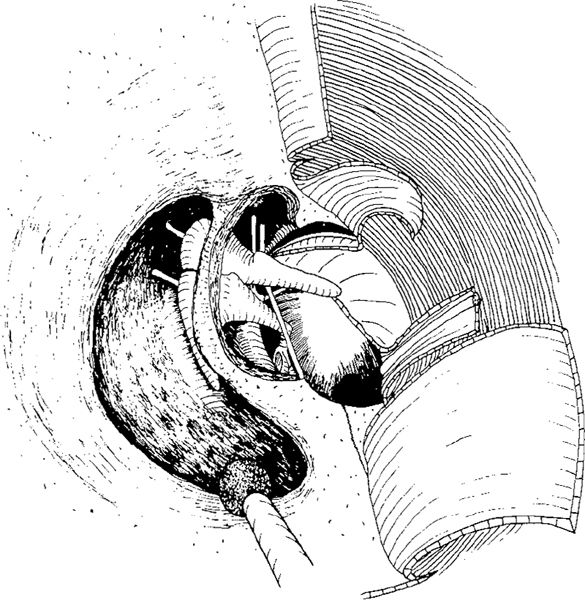
Fig. 539 The atticotomy opening is enlarged, and the bone from the mastoid tegmen and tegmen antri is drilled away. At the same time, the bony ear canal wall is also thinned on the mastoid side, and the antrotomy opening is enlarged
Stay updated, free articles. Join our Telegram channel

Full access? Get Clinical Tree


